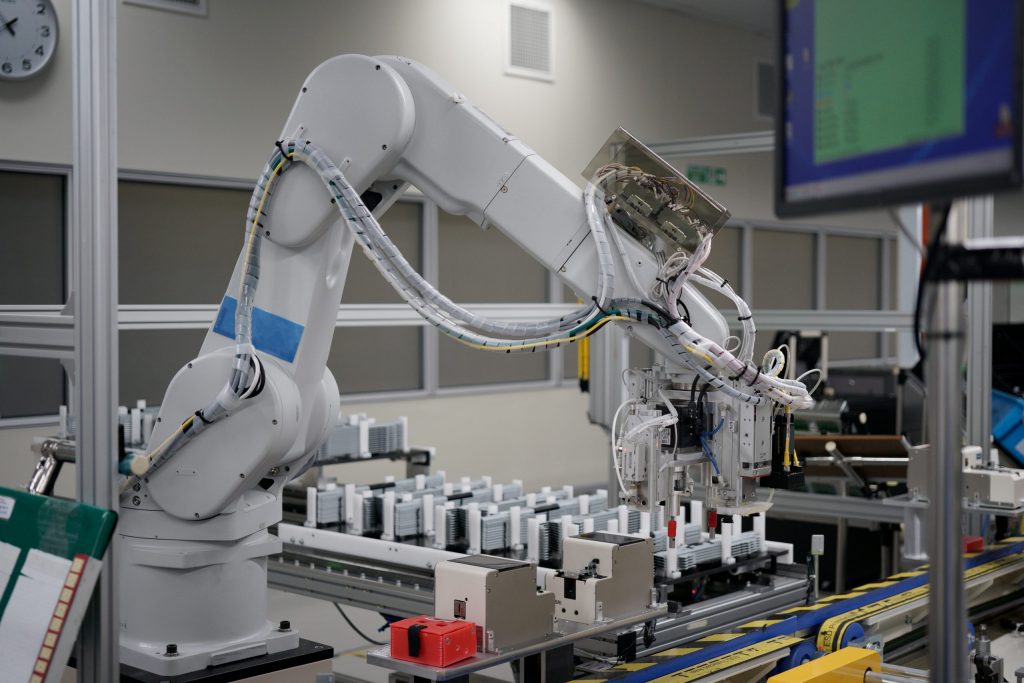Robotic part handling encompasses an incredibly diverse set of technology and tools, for which +Vantage is an experienced systems integrator and single source supplier. Robotic part handling, or material handling (MH) as the industry sometimes calls it, simply refers to removing human operators from the task of manually transporting materials, components and finished products from one portion of a manufacturing line to another.

Robotic part handling systems break down into categories, including multi-axis systems and varieties of gripping technology. These robots are not only cost-effective in terms of reducing payroll overhead and increasing throughput, but increase safety by removing the human component, eliminating the potential for material damage or injuries to your staff. The material handling market is expected to exceed $39 billion by this year, so let’s dive into what these machines do, and where they fit into your manufacturing, inspection and packaging processes.
Types of Material Handling Robots
3-Axis Robots

These are the most simple types of robots, referring to the 3 axes of motion about which they travel, generally translation along the X, Y and Z axes. These may not look like the large, yellow arms you conceptualize. Instead, they are often identical in practice to the extruder head on a 3D printer. This means gantry configurations which allow for vertical motion, and then 2D motion to a new position.
6-Axis Robots
6-Axis robots most commonly align with your expectation of what a material handling robot can do, and what it should look like. These armatures feature multiple rotation points, allowing for translation and rotation along and about the X, Y and Z axes. This means 6 degrees of freedom, allowing for twisting and movement in all directions.
Rail Mounted 7-Axis Robots
Rail mounted 7-axis robots add an additional degree of motion by mounting the entire armature on a rail system to move back and forth. This can be advantageous for extending the system’s range of motion, allowing it to pick up an object, move along the rail, and then place it down into a different portion of the manufacturing line. Alternatively, material can be delivered to a manual assembly station, where it can be safely handed off to an operator.
AGVs

AGV stands for automated guided vehicles, a technology which is increasingly being viewed as the future of warehousing automation. AGVs come in many sizes, from what might resemble an oversized robot vacuum to fully automated forklifts. Some even feature their own 6-Axis arms on top. An AGV can retrieve packages from designated positions and bring them to a handoff point for delivery or the next stage of their journey. Their primary applications thus far have been in warehousing, replacing human pickers, and allowing for lights out warehousing operations.
Pneumatic grippers
Pneumatic grip technology is a traditional method for a robotic system to interact with the options, utilizing compressed air (pneumatics) to apply pressure through a closed system. This in turn actuates the grip mechanism. Pneumatic grippers are mechanically simpler, operating on an open/closed basis and requiring less in the way of onboard encoders and motors. However, they will require a clean air supply in accordance with the needs of the pneumatic system.
Servo Drive Grippers
Servo drive grippers are the all-electric option for how a robot can grasp an item. These systems use electric motors, position sensors, motion encoders, and may even feature pressure sensors. This allows the gripper to apply variable pressure so as not to crush or damage delicate objects. Servo grippers are highly variable and can be coded to your exact specifications for each specific task.
Applications
Pick and Place
Pick and place is the most common application for robotic systems, reducing the time needed to move a component from one spot to another. This can be a simple automated process like taking a finished piece from one manufacturing cell and placing it at the input to another. A more integrated process might include a robotic armature tied into an inspection stage, which removes pieces as they fail inspection, and places them into a secondary location for material review or remanufacture.
Palletization
Palletization is one of the wonders of modern logistics. The process condenses shipments of goods from individual, haphazardly stacked boxes, into space-efficient pallets. In these units, material can be quickly moved, loaded and shipped. Robotic systems, owing to their precision and strength, are adept at palletizing your final product into an easily transportable form, saving human operators hours of backbreaking labor.
Automated Warehousing
True autonomy in your robotic systems enables a cascading effect of benefits for automated warehousing. This includes the reduction in manual labor, which reduces the number of shipping errors, and allows you to optimize for a highly rapid throughput without sacrificing the quality of services.
Want to learn more about how robotics automation can benefit your process? Contact us today!


